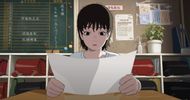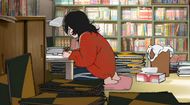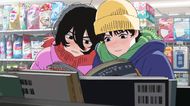Fujimoto delivered a quiet, heartbreaking one-shot titled Look Back, which has since been adapted into a 60-minute anime film that might just be one of the most beautiful animated works you’ll ever see. Fans might expect twisted surrealism or absurd black humor from Fujimoto, given his reputation. But Look Back is subdued. It’s intimate. It’s emotional in the most personal of ways.
At the core of this story is a girl who loves art. Fujino is the main character in this movie. She is a confident elementary schooler who publishes a comic strip in her school newspaper. Additionally, the star, the “art kid,” was admired by her classmates.
Until one day, a mysterious new artist named Kyomoto is added to the paper. No one’s ever seen her—she’s a shut-in—but her art is on another level. Fujino is stunned. Her world is shattered.
What follows is a quiet and powerful journey. Fujino, once so sure of herself, is consumed by jealousy. She draws obsessively to catch up, only to quit when she realizes she may never be as good. But when she’s tasked with delivering Kyomoto’s graduation certificate, she finally meets her rival, who turns out to be a timid, kind girl who has admired her work all along.

Fujino and Kyomoto are two halves of Fujimoto himself. You don’t have to squint to see it—Fujino is storytelling, raw passion, improvisation, while Kyomoto is technique, precision, and patience. Together, they make something whole. And just like Fujimoto’s actual work, especially Look Back, their story thrives on this contrast.
Fujimoto’s art style has always been sketchy, unpolished, but intentionally so. His manga feels cinematic not because it's "anime-ready," but because it echoes arthouse cinema more than shonen spectacle. Look Back uses minimalism to its emotional advantage. Time skips are shown through shifts in posture, in the background clutter of a room, and in the angles of light falling on sketchbooks.
As an autobiographical work, Look Back feels like Fujimoto processing his own creative burnout, his solitude during serialization, and maybe even his survivor's guilt because, after all, the story's tragedy draws eerie parallels to the 2019 Kyoto Animation arson attack, a moment that shook the entire anime industry.
Surprisingly, it’s the first half of Look Back that hits the hardest. Watching these two girls grow as artists, inspire each other, and become best friends is overwhelmingly sweet. It’s a portrait of creative passion and adolescent connection that feels universally human.
Even if most of the viewers are not familiar with the world of art, it is still relatable. The frustration of not being good enough. The quiet jealousy. The joy of finally getting something right. The scenes where they submit their first manga and run to the store to see it in print? Pure magic. The beauty lies not in grand declarations, but in the little things. In glances. In laughter. In spilled ink and shared erasers.
What is the core theme of this movie?

The core theme of Look Back isn’t success or failure. It’s perseverance. Art is hard. It’s not glamorous. One can draw all day and still hate what one has made. Artists sacrifice time, health, and friendships. For one moment. For one person who may smile at what they have made.
Fujino continues to draw not because she loves the process, it’s grueling, but because it connects her to people. Because it meant something to Kyomoto. Because it can mean something to someone else. That’s the power of art.
In an era where manga authors like Gege Akutami (Jujutsu Kaisen) and Yoshihiro Togashi (Hunter x Hunter) are open about the toll their work takes, Look Back feels more vital than ever. It reminds us that behind every published panel is a real human being giving pieces of themselves.
Why Look Back is essential viewing

You might be tempted to skip Look Back if you think it’s “just a drama” or “too slow.” But please, don’t. This isn’t just a film for artists. It’s a film for anyone who has ever felt unseen. For anyone who has chased a dream, failed, and tried again. For anyone who has lost someone and been changed forever.
It’s about what it means to make something with your own two hands and what it means to share that thing with someone else. Look Back doesn’t shout its emotions but chooses to whisper them. And in that whisper, it says more than most anime scream in 100 episodes. It’s one of the most beautiful anime films the audience will ever see. And it is not because of spectacle, but because of the soul.
